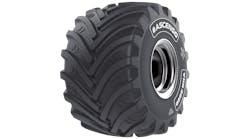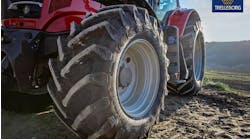Hindered by larger-than-desired inventory levels, rising input costs, high interest rates and other impediments, the North American ag tire market is down, but definitely not out. In fact, many ag tire manufacturers see blue skies ahead if a few factors swing their way.
In the MTD exclusive, ag tire manufacturers and suppliers provide an in-depth look at the current state of the ag tire market and what they expect to see in the coming year.
MTD: Can you describe the state of the North American ag tire market? What is demand like right now?
MARSHALL GILLESPIE, commercial tire director, American Tire Distributors Inc. (Hercules): Our view is that the ag market has been flat to down, depending on the segment. But as a newer brand into the ag space, Hercules continues to see growth year after year in both radial and bias.
RUUD NIJLAND, general manager, off-highway tires, Apollo Tyres Ltd. (Vredestein): Following its unprecedented high peak (in) 2021 and 2022, the market has pulled back in 2023. We estimate the market will end this year at (plus or minus) 80% of its latest peak, but still at a high level in a five-to seven-year cycle.
Despite the market decline, we expect to see further sales development, thanks to the extension of our product lines and growth of our distribution network.
ALAN ESKOW, vice president, BKT USA Inc.: Our survey with our ag distributors shows that 42% believe that the North American ag tire market has declined (in) 2023. Thirty percent believe that it has marginally increased. In 2023, the ag tire market has been a bit of a rollercoaster ride, but for BKT, this year was flat over 2022. 2023 started off with high inventory levels, hence the opportunity to get new orders was difficult. Because of harsh weather conditions earlier in the year, farmers have been hesitant to purchase new equipment and components, like tires, due to the expectation of low crop yields. If farmers have a successful harvest, then they will be more inclined to make new purchases.
TONY ORLANDO, president, Bridgestone Integrated Agricultural Tire Business, Americas, Europe, Middle East, India, Africa, Bridgestone Americas Inc.: We’re seeing softness in the North American ag tire market this year compared to 2022 and we’ll likely see further softening in 2024. There are a few reasons for this.
First, the ag economy continued to be challenged. Falling crop prices, high interest rates and rising input costs are pressuring farmers and causing reluctance to spend. Second, the good sales we saw as dealers and (original equipment manufacturers) built up inventory in 2022 have resulted in lower demand this year.
RYAN LOETHEN, president, CEAT Specialty Tires North America: The market this year is regionalized. Canada is up and the Midwest is starting to pick up. The West Coast and East Coast have been sluggish.
The North American ag tire market is continuing to recover from the whiplash of post-COVID-19 shipping rates dropping rapidly and global production quickly filling backorders. This created overpriced inventory. Distributors and dealers are essentially operating warehouses with two different price levels.
The ag tire segment usually deals with scarcity issues, but that’s certainly not been the case this year.
TONY CRESTA, director of product management, CMA LLC: Like many industries, we are seeing a return to normal in the North American ag tire market. In 2022, farm profits in the U.S. broke records. 2023 is going to be a down year in comparison, but only through the lens of 2022. Reports are showing that farm profits in 2023 actually will be (around) 22% above the 20-year average, even when adjusting dollars for inflation.
2022 gave supply chains and domestic inventory some whiplash. Last year at this time, we were still coming out of high ocean freight pricing and lengthy transit times.
GREG GILLAND, vice president, global agriculture, Maxam Tire North America Inc.: 2023 growth rates are stronger than the last eight years, but did not reach the peaks achieved in 2021 and 2022. The continuing market shift from bias to radial tires is evident, thanks to increasing, year-over-year radial demand compared to bias products.
In addition, the demand for tires in the above-100 hp (equipment) segments remains positive versus a year ago. The below-100 hp market has severely contracted as utility machinery sales have slowed down due to market inflation, rising operating costs and higher interest loan or bank rates.
DAVID GRADEN, global account manager, agriculture, Michelin North America Inc.: Overall, the ag tire market remains very stable. The amount of land and equipment in use experiences slow, longer-term changes. However, the mix between original equipment (OE) and (replacement tires) does fluctuate from year to year. In 2023, we experienced significant growth in the OE tire market and a subsequent decline in the (replacement) market.
PAUL HAWKINS, senior vice president, aftermarket sales and marketing, Titan International Inc.: Ag tire market sales have experienced a decline compared to the previous tear.
However, this year is still going to be one of our strongest in the aftermarket over the past decade. Current demand is steady as inventories are supplying farmers’ harvest needs and dealers restock for spring needs.
JAMES CROUCH, national segment manager, agriculture and forestry, Yokohama Off-Highway Tires America Inc. (Alliance): We’re still seeing the effects of inventories that built up in the wake of COVID-19 supply disruptions. Tires that were back-ordered in 2020 and 2021 turned into inventory last year and that’s still in dealerships’ and distributors’ warehouses.
Demand is strong among farmers, but there are plenty of tires on dealers’ racks right now to meet that need. This inventory has led to some lower orders placed to manufacturers this year versus previous years.
MTD: What will the market in 2024 look like?
GILLESPIE (ATD/Hercules): We see continued growth in the value tier space due to improved product quality and willingness of farmers to try new products due to changing market conditions.
NIJLAND (Apollo/Vredestein): Nobody really knows, of course, but we believe it can be expected — even if the economy falls further into a recession — that the market will stay flat compared to 2023 or show a slight increase. We further expect to see growing customer focus on the financial return on investment in their tire purchases and growing interest in tires that offer higher performance.
ESKOW (BKT): Over the last couple of months, distributors’ inventory levels have started to return to normal and purchases have started to increase. In the first quarter of 2024, we expect that purchases will remain flat. But from the second quarter of 2024 onwards, farmers will need to evaluate their need to maintain their equipment, which will help grow the ag tire market. For BKT, we expect double-digit growth in 2024.
ORLANDO (Bridgestone): We’re seeing two similar trends in the North American ag tire market, which we expect to continue going into 2024. There is a propensity for what we call ‘local for local,’ meaning local markets want local supply. In North America, this trend is continuing to be very important among our farmers and is partly a result of what happened during the COVID-19 pandemic, with supply chain interruptions and expensive import/export costs.
Farmers also are seeking more premium technology for agricultural tires. With the drive for more productivity, we see farmers adopt advanced increased flexion (IF)/very high flexion (VF) radial tire technologies that are ideal for large, heavyweight tractors and farm equipment.
LOETHEN (CEAT): Oversupply is working its way through the system and I anticipate pricing to ease its way back up in 2024. How the wars in Ukraine and the Middle East are resolved is the big wild card in 2024.
The Ukraine war disrupted the European market this year and contributed to oversupply here in North America. Demand will increase substantially once the Ukraine war is resolved. The Middle East war could have a negative impact on the production of larger ag tires and IF/VF tires, in particular, out of Israel.
CRESTA (CMA): Looking into our crystal ball and more accurately, our conversations with our ag dealers and partners, 2024 will continue to improve from where we started in 2023. 2022 ended with higher than normal domestic warehouse supply levels in the ag tire segment and many other segments. For the first half of 2023, this excess inventory became a concern, amplified by interest rate hikes and some delays in planting seasons.
As we get to the end of 2023, we are seeing the available domestic inventory return to normal, pre 2022 levels. As a manufacturer, this gives us hope for a strong 2024.
GILLAND (Maxam): If farm operating costs — such as fertilizer, fuel and seed — remain at the high 2022-2023 price peaks, we will see the agricultural tire market mirror 2023 levels as crop production and global demand will remain strong.
The support side of the ag tire business — mostly managed by smaller radials and/or bias tires — will remain challenged due to higher interest loan or bank rates.
GRADEN (Michelin): In 2024, we expect to see the start of a shift towards (replacement.) While net farm income is expected to remain high, it will likely pull back a bit and borrowing costs for new equipment should remain high. And both will dampen the OE market.
HAWKINS (Titan): Market conditions for large ag are poised for continued positive momentum into the near future. Despite current challenges — grain prices, input and interest costs — farmers will still be expected to fuel and feed the world.
Aftermarket sales could benefit, as many farmers choose to utilize existing equipment that will need to be maintained. The macro environment is showing strong signs of stabilization and guidance for 2024 suggests a continued solid performance.
CROUCH (Yokohama Off-Highway/ Alliance): I think 2024 will be a challenging year for farm tire manufacturers for two reasons. Dealers and distributors will still be clearing out built-up inventory and farmers will be more cautious about purchases in an election year. Election cycles always create uncertainty and a sense of risk, so farmers tend to tighten up and try to cut back on their expenditures.
We’re also currently waiting on a farm bill, so if that process bleeds into next year, it will put farmers even more on edge.




